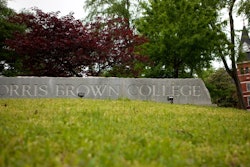Top 100 Undergraduate Degree Producers
Interpreting the Data
By Victor M. H. Borden, Pamela C. Brown and Olivia Majesky-Pullmann
Who were Alexander Lucius Twilight and Mary Jane Patterson? If you know, you are an excellent candidate for the “Jeopardy” category, “African-American firsts.” Knowing the topic of this edition of Diverse, you can probably guess the answer: “They were the first African-American male and female to be awarded bachelor’s degrees by a U.S. college or university.” Can you guess the years and colleges? For Twilight, it was in 1823, from Middlebury College. Patterson graduated in 1862 from Oberlin College. But despite the 39-year head start, males now represent a minority of bachelor’s degree recipients among African-Americans as well as within other racial/ethnic groups. In this year’s Top 100 undergraduate analysis, we explore trends in gender differences among racial/ethnic groups, as well as several other trends in bachelor’s degree conferrals.
Our trend analysis provides a broad context for processing the detailed Top 100 lists featured in this issue. Many people have a love-hate relationship with rankings. We love them when they place a favorable light on our own institution or our alma mater. But we question, ignore or reject them when they don’t. Despite, or perhaps because of, these emotional reactions, we feel compelled to read them. Diverse’s Top 100 listings are less controversial than many other rankings because they are very simple. We do not purport to be measuring institutional quality or value. We simply recognize those institutions that have conferred the largest number of degrees to minority students. Moreover, we do so across a wide range of disciplinary categories, allowing us to highlight the role of diverse institutions from across the U.S. higher education landscape.
Because our focus is on quantity (we leave it to market forces, government agencies and accreditation bodies to assure quality), we recognize that our listings tend to favor larger institutions. This year, available online only, we introduce into our analysis several views that accommodate smaller institutions. But first, we’ll describe the data source and methods used to assemble the Top 100 lists.
Source of Data & Methodology
This year’s report includes degrees conferred during the 2005-2006 academic year that have so far been reported to the U.S. Department of Education’s National Center for Education Statistics (NCES) through the Completions Survey of the Integrated Postsecondary Education Data Set (IPEDS). The preliminary data are complete and accurate for those institutions included in the analysis, which, in our experience, represents the vast majority of the country’s two- and four-year institutions. We welcome back this year the institutions in the Mississippi and Louisiana Gulf Coast region that were granted a reprieve from reporting last year due to the clean-up and rebuilding effort after Hurricanes Katrina and Rita. As one small reminder of the disaster, many of those institutions do not have prior year data and, and so are missing the indicator of percent change from the prior year.
The IPEDS Completion survey requests data on the number of degrees and other formal awards conferred in academic, vocational and continuing professional education programs. Institutions report their data according to the Classification of Instructional Program (CIP) codes developed by NCES. CIP codes provide a common set of categories, thus allowing comparisons across all colleges and universities.
The lists included in this analysis are based on students’ racial or ethnic status. This status is determined typically by a student’s self-reported response. The categories students are asked to choose from differ from one institution to another. However, when reporting enrollment or degrees to the federal government, institutions must “map” their categories to the standard federal categories: U.S. citizens or permanent residents are categorized as Black, non-Hispanic; American Indian or Alaskan Native; Asian or Pacific Islander; Hispanic; White, non-Hispanic; and race/ethnicity unknown. All non-U.S. citizens who are not permanent residents are categorized as non-resident alien, regardless of their race/ethnicity.
As usual, we restrict our analysis to institutions located in the 50 United States and the District of Columbia. We, therefore, exclude institutions from U.S. territories and protectorates, including Puerto Rico, Guam, Formosa, etc., as well as U.S. military service schools. We also include only those institutions that are eligible for Title IV federal funding by virtue of being accredited by a regional or specialized agency that is recognized by the U.S. Department of Education.
The institutions appearing in the published lists are ranked according to the total number of degrees awarded to minority students across all disciplines and in specific disciplines. Each list provides separate counts for males and females as well as the total count from the prior year (2004-2005) where available. The final two columns of the lists show two percentages. The first percentage indicates how the number of the minority degree recipients within a discipline compares to all degree recipients at that institution within that discipline. For example, in the listing of baccalaureates conferred to African-Americans in business and management, the percent indicates the proportion of all business and management baccalaureate degree recipients at that institution who were African-American. The second of these columns indicates the percentage change in that minority groups’ number of graduates at that institution from the prior year.
There are 100 institutions on the lists that combine all minority groups and disciplines by degree level. The lists for specific minority groups and for specific disciplines contain as many as 50 institutions each. A given list may have slightly fewer or more institutions because of ties in the rankings. For example, if there are four institutions that fall into the 48th ranked slot, then the list includes all of them, bringing the total number of institutions listed to 52. If, however, 10 institutions are tied in the 48th rank, all are excluded and so the list falls short at 47. A specific list may also be short because only a small number of degrees are conferred to that minority group within that discipline and/or degree level.
Overall Trends and Gender Differences
Total minority bachelor degrees continue to climb at a steady rate, while the number of degrees conferred to White students shows a more recent increase after several years of little growth. Figure 1 illustrates this 10-year trend. Figure 2 provides a more detailed view of the trend for each of the four racial/ethnic minority groups. Bachelor’s degrees conferred to Hispanics exceeded the number for Asian-Americans at the turn of the millennium, and the gap continues to increase. The trend for American Indians appears to be flat only because of the small numbers. Figure 3 provides a comparison of average annual percentage change for the 10-year period among all racial/ethnic groups. Hispanic numbers have increased at the highest average annual rate of 6.3 percent. The other minority groups, Asian-Americans, African-Americans, and American Indians, follow with respective growth rates averaging between 4.5 and 4.7 percent annually. When combined, the rate of increase among minorities has averaged 5 percent on an annual basis. Bachelor’s degree conferral to Whites has grown at the lowest rate, 1.7 percent annually.
Although the growth rate for minorities has exceeded that of Whites, the overall representation has changed only modestly. Figure 4 shows that White student representation has declined by 5.5 percentage points, from 77.8 to 72.3 percent. During this 10-year period, the representation of Hispanics has increased the most (2.2 percentage points), followed by African-Americans (1.6 percentage points) and Asian-Americans (1.4 percentage points). American Indians and international students have each gained one-tenth of 1 percentage point in representation.
Much has been written in recent years about the growth in female participation and, conversely, the declining presence of male college students, especially among African-Americans. Figure 5 explores the changes in gender distribution among bachelor’s degree recipients in roughly 10-year increments, from the mid-1970s to the present. Due to limited data availability in early years, we use 1976-1977 and 1986-1987 as our first two points of comparison, with 1995-1996 and 2005-2006 as our recent points.
The shift from males to females is a common phenomenon for all racial ethnic groups. However, because of different starting points, the shifts have differing implications. For example, among international students, the proportions have shifted from a predominance of males (72 percent in 1976-1977) to equity (50-50 in 2005-2006). Females became the majority among Whites in 1985-1986, and have increased their proportions since, now representing 57 percent of all White bachelor’s degree recipients. Males remained the majority of Asian-American bachelor’s degree recipients until 1995-1996 and are now similar in proportion to Whites, with 55 percent female representation. Hispanics and American Indians had gender representation rates similar to that of Whites in the two early decades but have had large increases in the proportion of females in the two more recent 10-year marks.
African-American gender representation was skewed toward females 30 years ago and is even more skewed today. Starting at the 57 percent female representation that now characterizes the majority White population, the relative proportion of African-American males declined to the point where females now outnumber males by 2 to 1. On the positive side, the 9-percentage point shift in gender representation among African-Americans is the smallest shift among the groups. Also, on a positive note, the absolute number of bachelor’s degrees conferred to African-American males has nearly doubled over the 30-year period, and their representation has increased from 2.7 percent to 3.2 percent of all bachelor’s degree recipients. However, the number of degrees conferred to African-American females has almost tripled over the 30-year period, and their representation among all bachelor’s degree recipients increased from 3.6 percent to 6.3 percent.
— Dr. Victor M. H. Borden is associate vice president and associate professor at Indiana University; Pamela C. Brown is associate director of enrollment services at Indiana University-Purdue University Indianapolis; and Olivia Majesky-Pullmann is the statistician/researcher for Diverse: Issues in Higher Education.
© Copyright 2005 by DiverseEducation.com





















